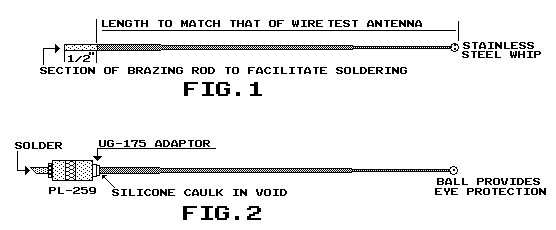Handy Leftovers
After giving the matter some thought, I decided that I needed to improve my H/T antenna for portable applications. Given the performance of my mobile, I decided that a quarter wave whip on my -2AT would give me the extra performance that I required, and since I had several stainless steel whips left over from various base loaded antennas, it seems like a logical project.
Using a test set up consisting of a field strength meter and my H/T with an external push to talk switch connected (so I could get close enough to see the meter), I began to experiment with various antenna lengths. Instead of snipping pieces of the antenna off as I pruned it, I made a test antenna consisting of a PL259 connector with a UG175 reducer screwed in. A 21″ piece of wire approximately the size of the steel whip, was soldered into the coaxial connector. Cutting off 1/4″ at a time I trimmed the antenna for maximum deflection.
Determining Length
The idea here, of course, is to determine how long the radiating element should be for optimum performance. Once I had determined how long the antenna needed to be, I measured and cut a piece of the whip, only half an inch shorter. I used the top portion of the whip; the little ball may theoretically be for corona suppression, but the most important thing it does here is provide some protection for your eye should you poke yourself. If your antenna is missing the ball, form one out of epoxy. It is a must.
Soldering Tip
In order to facilitate soldering the stainless steel whip, I joined a length of brazing rod to the butt end and cut it off, leaving half an inch of brass. Once I had filed the joint smooth, I tinned the brass and soldered it into the connector with no problem. It would have been better to have used a BNC connector, thereby eliminating the need for a UHF to BNC adaptor, but the end of the brass is too large to mate with the center conductor of the BNC. The adaptor poses no appreciable loss anyway, so there is no real problem.
With or Without Adapter
Once the antenna was assembled, I finished the job by carefully forcing silicone caulk into the cavity in the top end of the plug, between the UG175 and the whip, in order, to hold it steady. The point in using the adaptor, normally used to mate RG-58 to the larger PL259 plug, is to continue the 50 ohm impedance of the coaxial antenna to the bottom of the radiating element and to avoid a different impedance, as would exist between the whip and the connector, should the UG adaptor be left out. Quite frankly, this may not pose a problem. My first version of this antenna was made without the adaptor and it worked fine.

Better than the Average Duck
Obviously, the proof of any project is how well it works, and I can say that this one works just dandy. I have found in many cases, in situations where I could not access the repeater with the standard “duck”, I could with this antenna. If I was “scratchy” into the machine, the quarter wave antenna clears things up. Not having access to antenna test range and the required equipment, I can make no personal observations in regard to actual gain, but research has indicated that a full length quarter wave whip has 6db gain over a standard flexible H/T antenna.
Fast and Fun!
As you can pick up a factory made version of this antenna for $8 or $10, (editor-this may be dated info.) you may decide to go that route. But, if you are like me and have all the components on hand, fifteen minutes can get you on the air. Besides, half the fun of Ham Radio is in the building, modifying, and making do.
Originally posted on the AntennaX Online Magazine by John R. Somers, KC3YB
Last Updated : 6th March 2024
